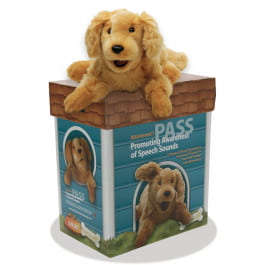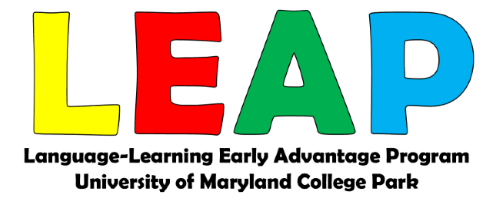Overview
The Language-Learning Early-Advantage Program (LEAP) is a therapeutic communication enrichment preschool located within the Hearing and Speech Clinic, founded in 1994 by the Department of Hearing & Speech Sciences at the University of Maryland. This program offers a comprehensive preschool curriculum with an emphasis on communication development and individualized speech and language therapy. The Maryland Association of Higher Education awarded LEAP the Distinguished Program Award in 1997. In April 2002, LEAP was selected as a model preschool reading program by the American Speech-Language-Hearing Association.
LEAP’s mission is threefold:
- To train speech-language pathology graduate and undergraduate students;
- To provide treatment to preschool-age children between the ages of 3 and 5 years who demonstrate speech and/or language delays in the absence of other handicapping conditions;
- To conduct research.
LEAP is a specialized program that is designed to support the development of communication and pre-literacy skills for children aged 3-5 years. Our program is focused on providing intensive instruction across communication domains.
All of our clients participate in a comprehensive initial evaluation to determine areas of need. We develop detailed individualized treatment plans that take into consideration each individuals’ strengths and weaknesses. Speech and language therapy is provided by graduate student clinicians who serve alongside licensed speech-language pathologists. We apply treatment approaches that are evidence-based and tailored to meet the needs of each of our clients. We provide both pull-out and push-in treatment sessions to help develop these skills.
Oral language is emphasized through the use of literature-based themes. Books and multi-sensory activities provide the fuel for oral narration. Student clinicians provide appropriate verbal scaffolding to assist children with verbal formulation in activities including storytelling and dramatic play. Third, cognitive skills are emphasized through concept development underlying vocabulary utilizing multi-sensory games and activities along with literature. Finally, sensory-motor skills are emphasized through fine and gross motor activities paired with music and language concepts.
Emergent Literacy
Emergent literacy is emphasized by systematic classroom training of the alphabetic principle. LEAP utilizes a multi-sensory approach in which a variety of activities, including music, drama, crafts, and play serve as mechanisms for establishing each phoneme-grapheme correspondence. We are focused on enhancing the foundational literacy skills for the kids in LEAP by developing skills in the areas of phonological awareness as well as print recognition and the ability to manipulate printed materials. Throughout instruction, auditory, visual, verbal, tactile, and kinesthetic cues are used to teach children the conventions of sounds and letters, and sound-letter combinations in English. Printed words are associated with objects throughout the classroom, and print conventions are discussed throughout the day.
We are committed to the development of, not only communication skills, but also pre-literacy skills. LEAP uses an instructional model that was developed at Ohio State University, titled Engaging Children with Print, which is available as a free e-book. You can download the book here: https://earlychildhood.ehe.osu.edu/files/2016/04/Engaging-Children-with-Print-Building-Early-Literacy-Skills.pdf
Phonological awareness is a critical skill in early literacy development. Literacy acquisition is fundamentally dependent on phonological awareness. As emerging readers, we rely on our ability to identify the constituent sounds that makes up words in order to learn what each word “sounds like”. For typically developing children, phonological awareness does not have to be explicitly taught; children acquire these skills as they are learning their language. When a child has strong phonological awareness skills, they are well-positioned to develop strong literacy skills in the future. Those children who have difficulty with phonological awareness may require additional support.
 It is important to underscore the point that phonological awareness itself is not the same as literacy, but it is a prerequisite skill. Literacy is our ability to decode and comprehend written text, but phonological awareness underlies our ability to become literate. Let’s look at an example like the word “dog”. When we look at this word, we need to be able to first identify that there are three individual letters, each with a corresponding sound. By taking each of these three sounds, and blending them together, we are essentially sounding the word out in our head. This process is commonly referred to as decoding. After putting these sounds together into a word, we can then search for this word in our mental dictionary to find the appropriate meaning. Although we may think of reading as a visual activity, one’s ability to recognize and parse out the individual sounds in written text is fundamental to reading.
It is important to underscore the point that phonological awareness itself is not the same as literacy, but it is a prerequisite skill. Literacy is our ability to decode and comprehend written text, but phonological awareness underlies our ability to become literate. Let’s look at an example like the word “dog”. When we look at this word, we need to be able to first identify that there are three individual letters, each with a corresponding sound. By taking each of these three sounds, and blending them together, we are essentially sounding the word out in our head. This process is commonly referred to as decoding. After putting these sounds together into a word, we can then search for this word in our mental dictionary to find the appropriate meaning. Although we may think of reading as a visual activity, one’s ability to recognize and parse out the individual sounds in written text is fundamental to reading.
In LEAP, we have designed our phonological awareness instruction on the Promoting Awareness of Speech Sounds (PASS) curriculum. PASS is a research-based pre-literacy program that incorporates multiple means of representation to engage students in learning opportunities.
Classroom Design
The classroom is a multi-centered, multi-sensory learning environment designed to foster growth in several critical areas. Each center within the classroom is intended to facilitate learning through a specific modality. This multi-sensory approach allows children to learn using multiple means of exposure to different concepts.
The physical areas within the classroom are as follows:
- The circle rug is where the day starts and ends. Here, children sit on alphabet mats for structured activities. The physical space of the circle rug area is shared with the reading area. This area is well stocked with a variety of literature, organized by classroom theme. A separate rack is filled with library books related to the current classroom theme. A variety of different seating options invites both the early reader and pre-reader.
- The symbolic play area consists of a range of age-appropriate toys for children to interact with. This area contains things such as blocks, cars, trains, dolls, and animals.
- The dramatic play area contains child-sized household items, representational and imaginative toys, puppets and a puppet theater, costumes, musical instruments, and multiple bins containing categories of toys clearly marked with pictures and words.
- The gross-motor area is comprised of a large climbing/sliding play structure, balls and other materials to encourage strength and coordination.
- The fine-motor area contains arts and crafts activities, puzzles, and social communication activities involving manipulation of game pieces.
- Finally, there is a large table area which children use for classroom structured activities, creative play with clay and paint, cooking activities, snack, and other miscellaneous activities. The classroom also contains a kitchen with refrigerator, sink, cabinets and counter space.
Parent Engagement
Parent engagement is one of the most critical components for any intervention program. Parents and caregivers of LEAPsters are provided with as much engagement as possible. We provide regular updates regarding progress in therapy to our parents. Parent conferences are conducted formally twice every semester to discuss the goals and progress of each child. Homework is provided to reinforce goals achieved in therapy and in the classroom.
Read some of our reviews below!
“One visit to the LEAP premises was enough: we said to each other, ‘This is the place!'”
”We feel very fortunate to have stumbled upon LEAP. Your program has made a dramatic improvement in (our daughter’s) speech and language development. We feel that the program’s remarkable success … is attributable to the small class size and the low student-clinician ratio … as well as the warmth and love you have shown to the children in LEAP…”
“In a matter of four weeks in LEAP, we saw incredible progress in (our son). We would strongly recommend this program to anyone who has a preschool child with needs like our son.”
“(Our daughter) has thrived so beautifully in LEAP and is now prepared to make the transition to kindergarten. Please know that you have our deepest respect and admiration.”

